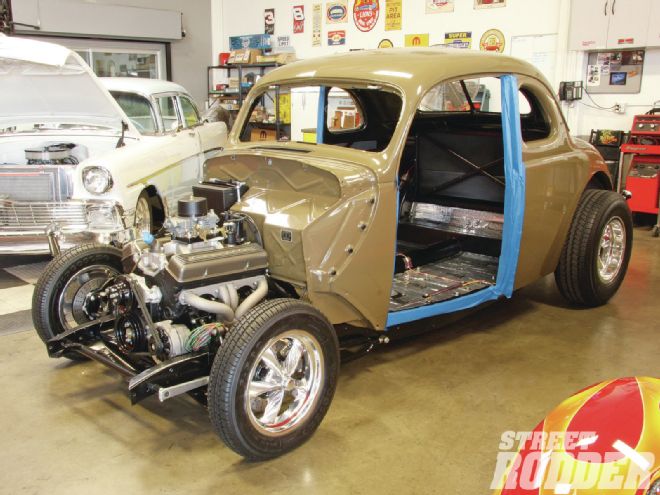
There are a lot of rods out there whose owners are interested in having a laundry list of creature comforts, everything from air conditioning, cruise control, and a remote CD changer in the trunk, to power windows and door locks, electric decklid opener, and six-way adjustable heated seating. But when you’re going for a particular look for your ride, say maybe something a bit more traditional (or at least something from the early ’60s), then having items such as slide switches and vents made of billet aluminum would look out of place.
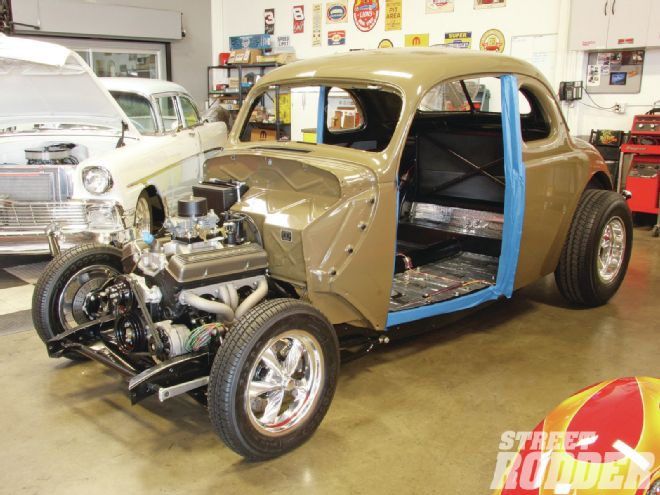 A few months before its debut at the 2011 Grand National Roadster Show, this was Ryan Reed’s ’37 as it was delivered to Alan Hickman’s Audio Shoppe in Riverside, CA.
A few months before its debut at the 2011 Grand National Roadster Show, this was Ryan Reed’s ’37 as it was delivered to Alan Hickman’s Audio Shoppe in Riverside, CA.
Imagine walking up to a sharp-looking car, something that might appeal to your basic hot rod sensibilities, only to find a detachable-face stereo head unit smack dab in the middle of the vintage dash? It seems getting tunes out of your hot rod has always been something of a trade-off for rodders. Either you use some kind of bulky head unit and big speakers that don’t hide very well or you go without—not really much of a choice.
Ryan Reed, who in his young life started building rods in Southern California with “Fat Jack” Robinson and then spent 10 years at SO-CAL Speed Shop, is now out on his own working on both customer’s cars and projects for himself. His latest personal ride is an olive-green 1937 Ford coupe that debuted at the Grand National Roadster Show earlier this year and, as anyone who has seen Reed’s work up close can tell you, he is about as fastidious as they come—and we mean that in a good way!
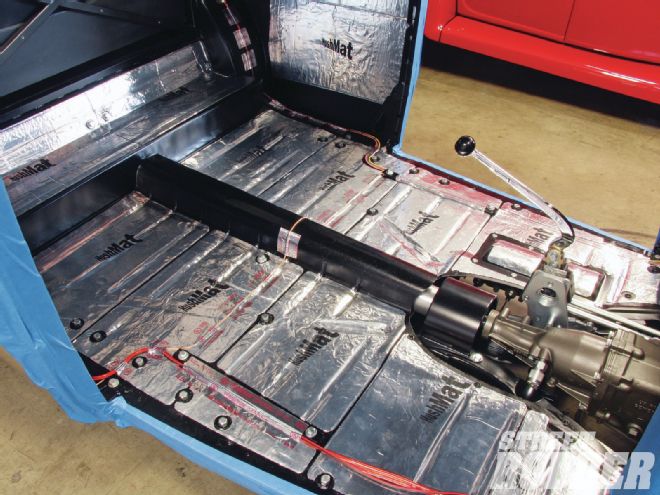 Reed and Hickman installed Hush Mat material on the floor, quarter-panels, roof, and in the trunk to help reduce road noise, deaden vibrations, and provide extra protection from heat.
Reed and Hickman installed Hush Mat material on the floor, quarter-panels, roof, and in the trunk to help reduce road noise, deaden vibrations, and provide extra protection from heat.
Anything Reed builds will have the kind of attention to detail usually reserved for Pebble Beach kind of restorations or AMBR and Ridler contenders. So when Reed decided he wanted to have some tunes in his ’37, he already knew he didn’t want to see any evidence that an audio system was present. Reed believes cars of a certain era, such as those from the ’50s and ’60s, lend themselves to having stereo systems be visible to the observer because they were already designed by the factory to have something in the dash just for that. But simplicity was the hallmark for most hot rod candidates from the teens, ’20s and ’30s, and Reed certainly didn’t want the stereo controls be the first thing someone would see when viewing the interior of his coupe.
While at SO-CAL, Reed had the chance to work a few times with Alan Hickman from Audio Shoppe in Riverside, California. Hickman’s company is who SO-CAL turns to when they want to have a big-sounding audio system installed but don’t want to see any of it. With the rapid advancements in stereo gear these past few years and the miniaturization of many of the components, you can now build an audio system with substantial power and hide it so well no one would ever know it’s there.
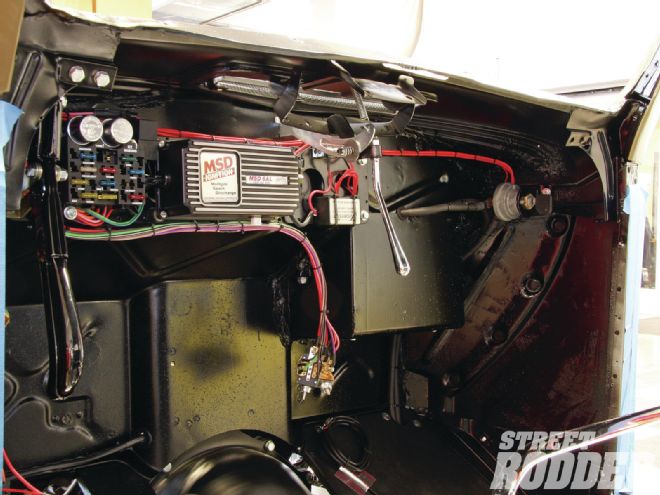 Does your underdash look this clean? This is an example of the high level of attention to detail Reed puts into the cars he builds.
Does your underdash look this clean? This is an example of the high level of attention to detail Reed puts into the cars he builds.
And when it comes to stereo gear, Reed may have met his match with Hickman as he understands every aspect of how sound moves through the air, and the best way to not only harness it, but to make it work at its peak performance for each individual case. In other words, nearly anybody can grill a steak at home, but when you can get a master chef to do it for you, why risk burning a good piece of meat by doing it yourself?
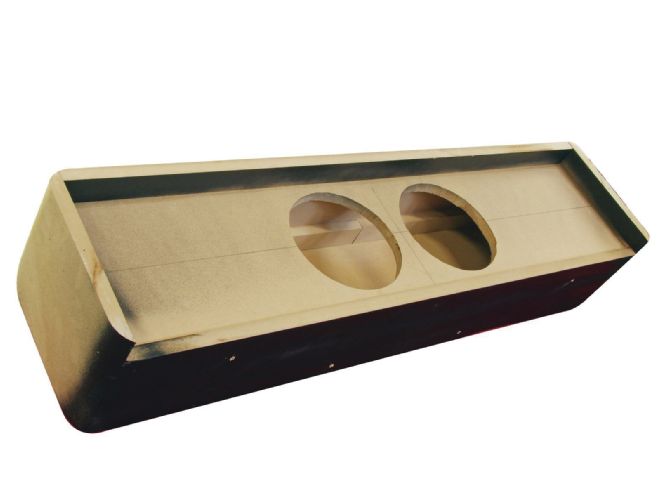 There really is a science in figuring out how sound moves through the air, and Hickman understands how it works. He designed this down-firing, slot-loaded, subwoofer enclosure to maximize the effect. It’s roughly 42 inches wide, 10 inches deep, and 9 inches tall and made out of 3/4-inch MDF.
There really is a science in figuring out how sound moves through the air, and Hickman understands how it works. He designed this down-firing, slot-loaded, subwoofer enclosure to maximize the effect. It’s roughly 42 inches wide, 10 inches deep, and 9 inches tall and made out of 3/4-inch MDF.
Reed had a couple of requirements for his car in that he didn’t need or want a stereo head unit. All of his music would come from his fifth-generation Apple iPod Nano. With a capacity of 8 GB (with enough space for roughly 2,000 songs), the fifth-gen Nano weighs less than 1.5 ounces and measures less than 4x2 inches (Apple’s latest sixth-gen Nano is less than 2 inches square!). The rest of the system, which as Hickman designed it would include a pre-amp, a master volume control, a four-channel mini-amp, four 5-1/4-inch speakers, twin 8-inch subwoofers (mounted in a handmade, custom-tuned enclosure), and sound-deadening material (from Hush Mat) will all be hidden from view.
Work began at Audio Shoppe after Reed delivered his ’37 sans any interior. Hush Mat, from Olathe, Kansas, produces the foil-backed, sound-deadening material used in the car, which also serves as a vibration reducer and a thermal barrier. Once Hickman designed the special subwoofer enclosure and installed and wired the rest of the system using Arc Audio gear, the car went to Gabe’s Street Rod Custom Interior in San Bernardino, California, where owner Gabe Lopez crafted an old-time interior for Reed’s ride that hid every component of the audio system. Lopez’s interiors have been used by hundreds of street rod owners, including many Ridler- and AMBR-winning hot rods.
The system, as it turns out, works really well and, despite his best efforts, Reed can easily hear his music over the exhaust note produced by his engine, even while cruising down the highway or burning the hides in a friend’s driveway.
There’s no evidence of a big-sound speaker system once Gabe gets the rear section covered either. The slot is behind the material, just above the mini storage box mounted over the tunnel. An advantage was in the material choice: fabric instead of leather (which would have necessitated holes punched in it or vents attached).